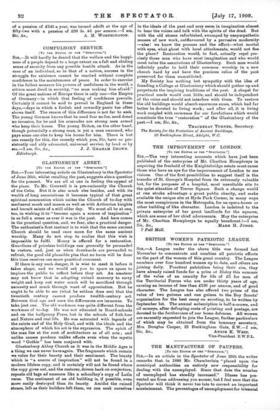GLASTONBURY ABBEY.
[To THE EDITOR OP THE " SPICTATOR.1
Sin,—Your interesting article on Glastonbury in the Spectator of June 26th, whilst recalling the past, suggests also a question for the present. We are all at one in feeling the appeal of the place. To Mr. Greswell it is pre-emineutly the Church of the Celts. But it is also much else besides, and with its wealth of long associations it becomes typical of that great spiritual communion which unites the Church of to-day with mediaeval monk and mason as well as with Arthurian knights and hermit saints of a still older day. We must all be at one, too, in wishing it to "become again a source of inspiration" in as full a sense as ever it was in the past. And here comes in the practical question, and, we fear, also a practical danger. The enthusiast's first instinct is to wish that the same ancient Church should be used once more for the same ancient worship. Many do not stop to realise that this wish is impossible to fulfil. Money is offered for a restoration. Guardians of priceless buildings can generally be persuaded to restore, and, just as when drunkards are persuaded to refresh, the good old plausible plea that no harm will be done this time receives one more practical coin ment.
If there is any such danger, it is wise to meet it before it takes shape, and we would ask you to spare us space to implore the public to reflect before they act. An amateur may not know that in adapting ruined masonry to carry weight and keep out water much will be sacrificed through necessity and much through want of appreciation. But he ought to be able to see (what be seldom does see) that the twentieth century cannot produce twelfth-century art. Between that age and ours the differences are immense. To take just one. , The old workman was quite different from the workman of to-day. He was not educated in Board-schools and on the halfpenny Press, but in the schools of folk-lore and Nature and real life. He was saturated with legends of the saints and of the Holy Grail, and with the ideals and the atmosphere of which his art is the expression. The spirit of the man lies at the root of architecture as of all arts ; and unlike causes produce unlike effects even when the mystic word " Gothic " has been conjured with.
Glastonbury Abbey Church as it was in the Middle Ages is a thing we can never have again. The fragments which remain we value for their beauty and their sentiment. The beauty which is "a source of inspiration" will not be found in a modern lifeless copy, and it certainly will not be found where the copy gives out, and the restorer, driven back on conjecture, repeats old tags ad nauseant like a schoolboy's copy of Latin verse. The sentiment of an old building is, if possible, even more easily destroyed than its beauty. Amidst the ruined stones, left as their builders left them, we can soak ourselves
in the ideals of the past and may seem in imagination almost to Lear the voices and talk with the spirits of the dead. But with the old stones refurbished, swamped by unsympathetic masses of new work, outflavoured by a pervasive modernity —alas! we know the process and the effect—what mortal with eyes, what ghost with local attachments, would not flee the place? Restoration would, in fact, actually repel pre- cisely those men who have most imagination and who would most value the associations of Glastonbury. Such men would. infinitely prefer to hold their common worship in a new church hard by and have the precious relics of the past preserved for them uninutilated.
My Society has nothing but sympathy with the idea of founding a College at Glastonbury which should gather up and: perpetuate the inspiring traditions of the past. A chapel for practical needs would cost little, and should be independent of the ruins and should not interfere with them. To restore the old buildings would absorb enormous sums, which had far better be devoted to living work; and after all, it is living work coupled with reverence for our forefathers which would constitute the true " restoration " of the Glastonbury of the past.—I am, Sir, &c., THACKERAY TURNER, Secretary.
The Society for the Protection of Ancient Buildings, 20 Buckingham Street, Adelphi, W.C.








































 Previous page
Previous page